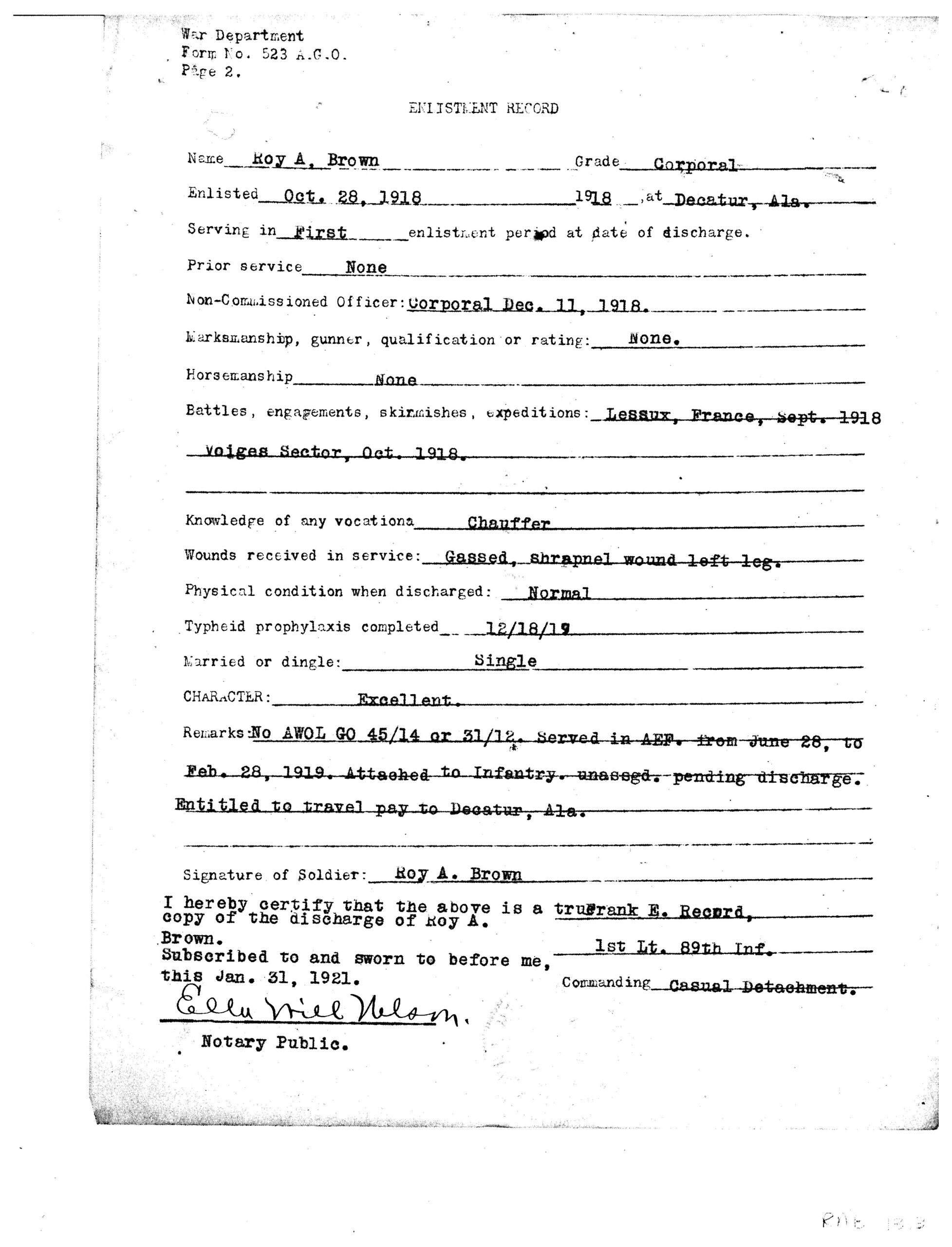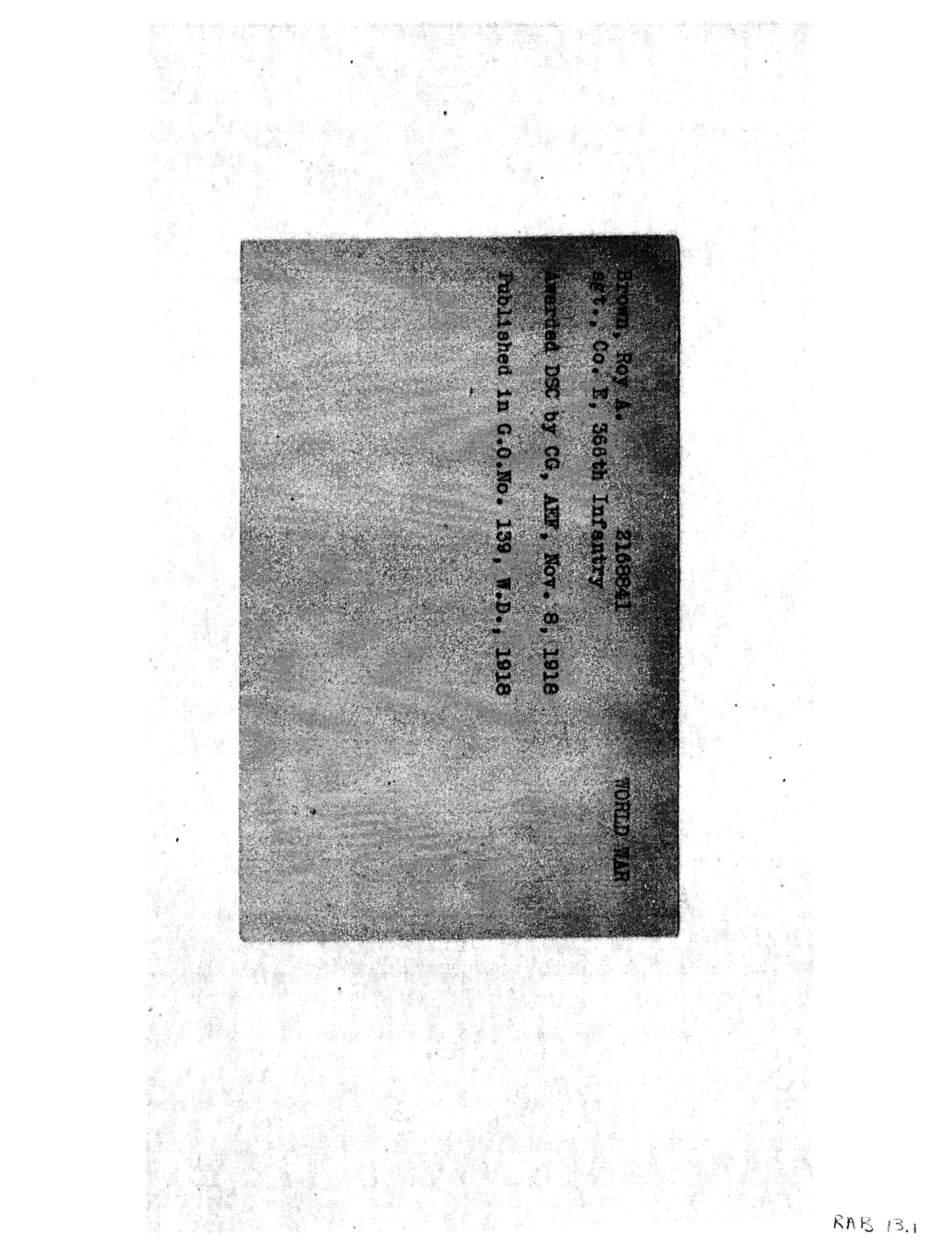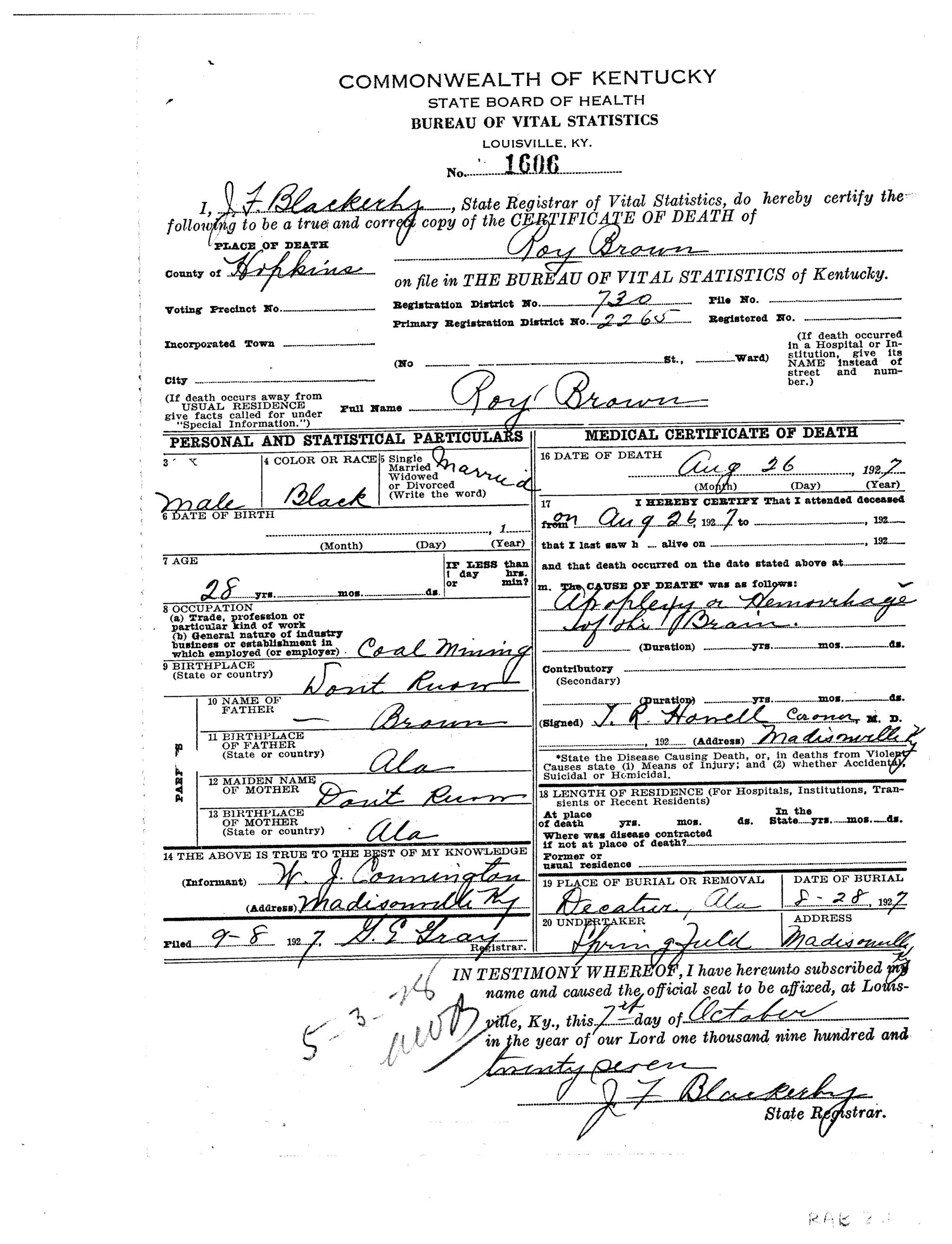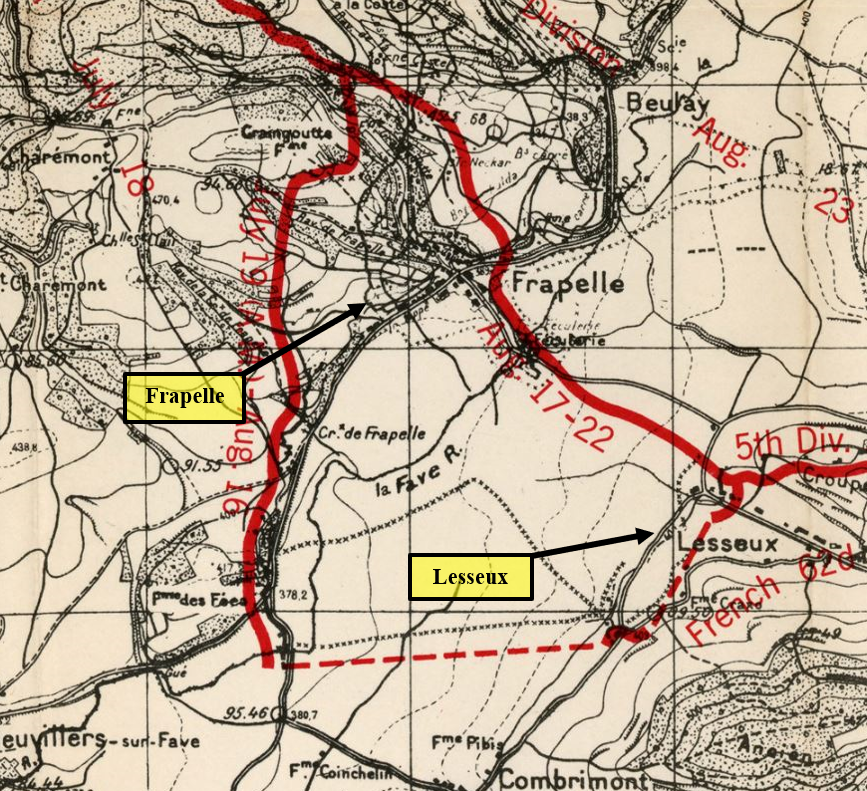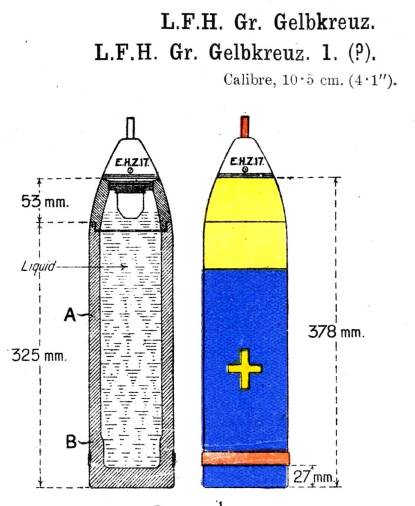Roy Admiral Brown
Roy Admiral Brown’s Personal Narrative was derived from information found in public records, military personnel files, and local/state historical association materials. Please note that the Robb Centre never fully closes the book on our servicemembers; as new information becomes available, narratives will be updated to appropriately represent the life story of each veteran.
Please contact the Robb Centre for further clarification or questions regarding content or materials.
Military Honor(s):
Distinguished Service Cross
Citation: The President of the United States of America, authorized by Act of Congress, July 9, 1918, takes pleasure in presenting the Distinguished Service Cross to Sergeant Roy A. Brown (ASN: 2168841), United States Army, for extraordinary heroism in action while serving with Company E, 366th Infantry Regiment, 92d Division, A.E.F., near Lesseau, France, 4 September 1918. Sergeant Brown was a member of a combat group which was attacked by 20 of an enemy raiding party, advancing under a heavy barrage and using liquid fire. The sergeant in charge of the group was killed and several others, including Private Brown, were wounded. Nevertheless this soldier, with three others, fearlessly resisted the enemy until they were driven off.
Life & Service
- Birth: 9 February 1897, Decatur, AL, United States
- Place of Residence:
- Race/Ethnicity: African American
- Death: 26 August 1927 Christian, KY, United States
- Branch: French XXXIII Corps Army
- Military Rank: Sergeant
- Company: [E]
- Infantry Regiment: 366th
- Division: 92nd
Personal Narrative
Roy Admiral Brown was born to Alex L. (1870-?) and Ellen Wood Brown (1860-?) on 9 February 1897 in Decatur, Alabama, the youngest of his full siblings, Isaac (1887-1956), and Herman (1895-1941).
Brown enlisted in the U.S. Army on 28 October, 1917 in Decatur, Alabama, as a Private. Brown and his Company sailed to Brest, France on the U.S. Army Transport Ship, Vauban on 14 June 1918, arriving on 20 June. On 2 September, then-Sergeant Brown was wounded in the left leg due to shrapnel in the St. Die-Frappelle Sector, France, and later gassed on 11 November. Sgt. Brown received the Distinguished Service Cross for his service in Lesseau, France, on 4 September 1918:
“The President of the United States of America, authorized by Act of Congress, July 9, 1918, takes pleasure in presenting the Distinguished Service Cross to Sergeant Roy A. Brown (ASN: 2168841), United States Army, for extraordinary heroism in action while serving with Company E, 366th Infantry Regiment, 92d Division, A.E.F., near Lesseau, France, 4 September 1918. Sergeant Brown was a member of a combat group which was attacked by 20 of an enemy raiding party, advancing under a heavy barrage and using liquid fire. The sergeant in charge of the group was killed and several others, including Private Brown, were wounded. Nevertheless, this soldier, with three others, fearlessly resisted the enemy until they were driven off”.
Sergeant Brown and his Company sailed to Camp Upton, New York, on the U.S. Army Transport Ship Aquitania on 22 February 1919, arriving on 28 February. Sergeant Brown was Honorably Discharged on March 22, 1919 at Fort Oglethorpe in Catoosa County, Georgia (there are issues with his rank between late 1918 and 1919; he appears by multiple records to have been back and forth between Corporal and Sergeant, with no clear reasoning as to why it is the case).
At the time of his act of valor on 4 September, 1918, Sergeant Roy A. Brown, then a Private, was serving in Company [E], 366th Infantry Regiment, 183rd Infantry Brigade, 92nd Division of the American Expeditionary Forces. What follows is his story.
The Saint-Dié Sector – 4 September 1918
August 1918:
Nestled deep within the Vosges Mountains of Northeastern France, the frontline in the Saint-Dié Sector was settled during the early months of the First World War. Though artillery attacks, aerial bombardment, and sporadic gunfights were still common throughout the intervening years of the war, it was not until August 1918 that anyone showed an interest in altering the status-quo. While the sector was still under French command, the American 6th Infantry Regiment, 5th Infantry Division, carried out a surprise attack on the German-occupied village of Frapelle, capturing it on 17 August. Enraged, the Germans quickly assembled their own forces to retake the town. Heavy artillery and first-rate Prussian infantry were summoned from outside of the sector to bolster the second-rate Alsatian troops that had previously held the line. Through the month of August, 1918, the German systematically blasted both the American and neighboring French lines with high-explosive and gas shells in retribution for the loss of Frapelle.
As the retaliatory bombardment was well underway, the American 92nd Infantry Division, with the exception of the 167th Field Artillery Brigade, began to relieve the 5th Infantry Division in the Saint-Dié Sector. On 23 August, as control of the hot-zone around Frapelle passed from the 6th Infantry Regiment to the 366th Regiment, German artillery razed what was left of the town following 4 long years of war. The 92nd Division suffered its first casualties from enemy fire during this attack, including 2 killed and 6 critically wounded. Regardless, the men of the 92nd Infantry Division, with guidance from the French 87th Division, quickly got to work reorganizing the unstable frontline that had been left for them.
1-3 September 1918:
In the late hours of 31 August, the Germans launched a large assault on the 92nd Division’s trenches, and heavy fighting broke out around Frapelle until the following morning. German flamethrowers and bombs lit up the night while the thunder of heavy artillery shook the earth. A bloody battle raged through the mountains between the men of the 92nd Division and the attacking German Infantry until artillery support from the French XXXIII Corps drove the Germans off. However, the enemy returned that afternoon and, on the slopes of Mount Ormont to the Northwest of Frapelle, a second round of violence broke out from 1230 Hours (12:30 PM) until 1500 Hours (3:00 PM), when the combined efforts of the 365th and 366th Infantry Regiments were able to clear the field. At the end of the first day, the 92nd Division counted 34 gassed and wounded with 8 dead, though this number rapidly grew over the coming days.

3rd Battalion, 366th Infantry Regiment performing gasmask drills at Ainville, Vosges France – 8 August, 1918.
On 2 September the Germans settled for an intense bombardment while they recovered from the previous day’s fighting. Artillery hammered the 92nd Division’s frontline throughout the day, sewing chaos and destruction through their ranks. It was likely during this barrage that Roy A. Brown, a private at the time, suffered a shrapnel wound to his left leg. Additionally, in another incident, smoke from burning explosive residue grew so thick that one officer and several men from the 92nd Division did not realize that they had also been gassed. This, and other incidents like it, helped the 92nd Division’s gas officer to identify a number of flaws in their divisional gas defense, which would more-or-less plague the 92nd Division throughout the war.
The following day, on 3 September, the Germans directly attacked the 366th Infantry Division’s front once more. During the ensuing firefight, Second Lieutenant Aaron Fisher demonstrated exemplary courage when he, after being badly wounded, remained in the field to command his troops. In some ways, the heroism demonstrated by Lieutenant Fisher served as a role-model for the men of the 366th Regiment in the coming days, as many men chose to remain in the fight despite being, sometimes critically, wounded in action.
4 September 1918:
On 4 September, the Germans attacked once more and in larger numbers. Following a devastating minenwerfer barrage, the sergeant commanding Private Roy A. Brown’s combat group and several other men were killed or critically wounded. Brown, himself still recovering from the shrapnel wound he had sustained only two days prior, and a handful of other soldiers who could still fight were left alone against a large, fast-approaching group of well-armed German raiders. However, even as terrifying ribbons of liquid-fire burst forth from the raiders’ wechselapparat flamethrowers, Brown and the small group of soldiers stood their ground and courageously resisted the enemy attack. It is because of their actions that the Germans were unable to make any gains in the Saint-Dié Sector
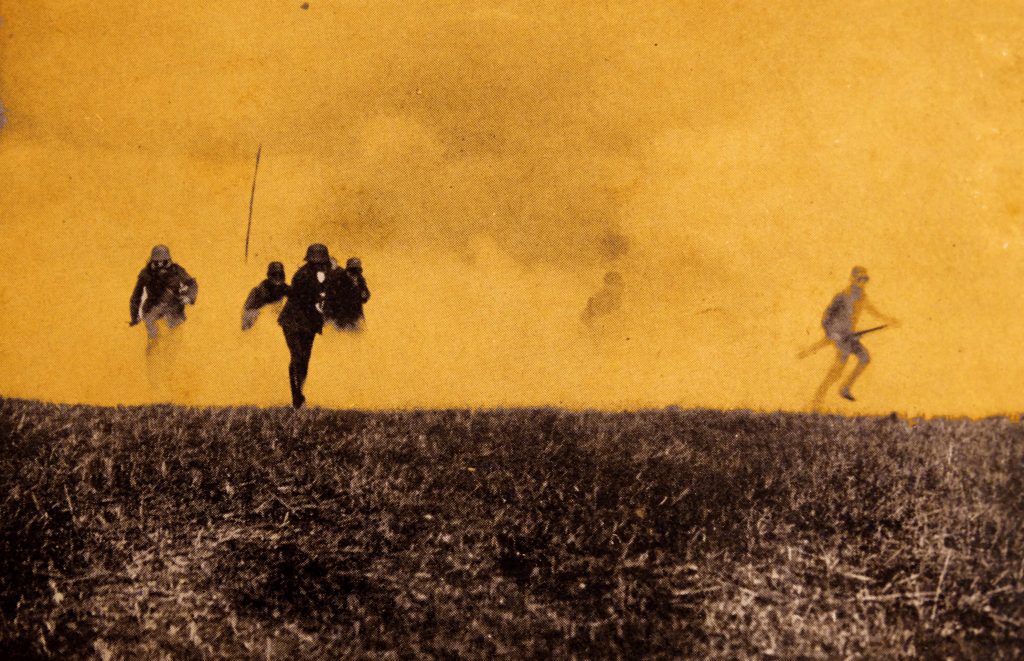
A German gas attack on soldiers during World War One. Dated 1914. (Universal History Archive/UIG via Getty Images) – Colourized
For his part in this brave show of defiance, Roy A. Brown was awarded the Distinguished Service Cross on September 4, 1918, under General Orders No. 139. He was presented with this medal on 2 December, 1918, while his unit was headquartered at Pont-à-Mousson, France.
Several other members of the 92nd Infantry Division were recognized for their actions near Lesseux on September 4, 1918. Their names and links to their own Personal Narratives are included below.
Corporal Van Horton, [E] Company, 366th Infantry Regiment.
Private First-Class William Clincey, [F] Company, 366th Infantry Regiment.
Private George W. Bell, [E] Company, 366th Infantry Regiment.
Private Alex Hammond, [E] Company, 366th Infantry Regiment.
Private Edward L. Merrifield, [E] Company, 366th Infantry Regiment.
In the early 1920s, Brown attended several classes through the Federal Board for Vocational Education in Auburn, Alabama to become a Veterinarian. Brown worked various professions; a driver in a chauffeur service in Decatur, Alabama; in the Coca-Cola Bottling Work Factory in Decatur, Alabama, and finally as a coal miner in Madisonville, Kentucky. Brown died of a brain hemorrhage due to a coal mining accident on 26 August 1927. Further research into the “coal mining” incident (reported by his death certificate) has come up with little to no results- his name was not on casualty lists associated with the 3 August 1927 West KY #7, Clay-Webster Co. mining disaster or any incidents related to the Grapevine Coal Co., Hurt Coal Co., Norton Coal Mine Co., or West KY Coal Co., all in the region of his reported death place. Hundreds of singular incidents occurred all over the state each year- this is the most likely explanation for his death- an isolated incident that was not followed up with any public reports.
From the Files of Roy A. Brown
